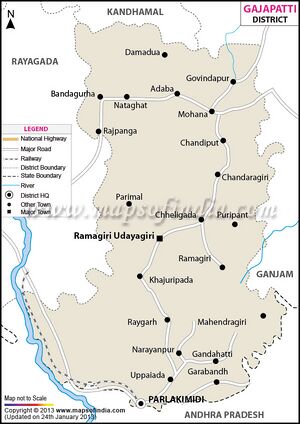Gajapati

Gajapati (गजपति) is a district of Odisha, India. It was created from Ganjam District in October, 1992. The district headquarter is at Paralakhemundi.
Jat clans
- Gazwa (गज़वा)
Origin of name
Gajapati district was named after Maharaja Sri Krushna Chandra Gajapati Narayan Dev, the Raja of the Paralakhemundi estate (the first Chief Minister of the state), who is remembered for his contribution in the formation of a separate state, and inclusion of the Paralakhemundi estate in Odisha.
Paralakhemundi is the District Headquarters and also the largest town of the Gajapati district. Kashinagara is the second largest town of Gajapati district.
Mahendragiri
The epic mountain Mahendragiri, a segment of Eastern Ghats is situated in paralakhemundi. Legend says that it is the place where lord Parashurama, a chiranjeevi staying eternally and doing tapasya. Temples built by Pandavas are seen. Main festival here is Shivaratri, the worship of Shiva, the guru or percepter of lord Parashurama.
History
History of Gajapati district goes back to the Paralakhemundi kingdom. It was part of the Gajapati Kingdom of Odisha. During 12th century CE Parala Khemundi was part of the Khemundi state. During the reign of Mukunda Dev Khemundi was trifurcated creating 3 states Bada Khemundi, Sana Khemundi and Paralakhemundi. After the trifurcation, Subhalinga Bhanu became the ruler of the Paralakhemundi. This line of kings continued to rule Paralakhemundi throughout the Mughal Maratha rule of Odisha. Before the British completed control of Odisha, Parala became a feudal state of British Raj during the reign of Gajapati Jagannatha Narayanadev in 1767. The state had some conflict with the British administrators. The king Gajapati Jagannatha Narayanadev and his son was arrested by the British. The state then came under direct British supervision. There was a revolt among the tribals and Paikas of the state against the King's detention. Due to this, the King was reinstated to his position. [1] Paralakhemundi remained under the administration as a feudatory state until its unification with Odisha.[2] One of the prominent kings of Parala was Krushna Chandra Gajapati. He was an active member of Utkal Sammilani and was instrumental in creating the separate state for Odisha. Finally, with the effort of Maharaja Krushna Chandra Gajapati and Utkal Sammilani, the separate state of United Odisha was formed on 1 April 1936. The state of Paralkhemundi in Vizagapatam district was partitioned into two – with the capital and most of the princely state coming under Orissa and the remaining Telugu-speaking areas remained under Madras Presidency. In 1937, the first Governor of Odisha, Sir John Austin Hubback invited Krushna Chandra Gajapati Dev to form the cabinet. Shri Gajapati was the first Prime Minister of the Odisha state from 1 April 1937 to 18 July 1937. He was the Prime Minister of Odisha for the second time from 24 November 1941 to 30 June 1944.[3]
गजपति ज़िला
गजपति ज़िला भारत के ओड़िशा राज्य का एक ज़िला है। ज़िले का मुख्यालय पारलाखेमूंदी है। यह 1992 में गंजम ज़िले को तोड़कर बनाया गया था।
References
- ↑ Dāsa, P.; Sahitya Akademi (2002). Bhakta Kavi Gopāla Krishna. Makers of Indian literature (in Latvian). Sahitya Akademi. pp. 97–99. ISBN 978-81-260-1201-5.
- ↑ Acharya, P. (2008). National Movement and Politics in Orissa, 1920-1929. SAGE Series in Modern Indian History. SAGE Publications. p. 1. ISBN 978-81-321-0001-0.
- ↑ Orissa Tourism Development Corporation; Orissa (India). Dept. of Home (1980). The Heritage of Orissa. Produced by Orissa Tourism Development Corporation for the Department of Home, Government of Orissa. p. 87.
Back to Jat Kingdoms in Ancient India/Jats in Buddhism
Back to Orissa

